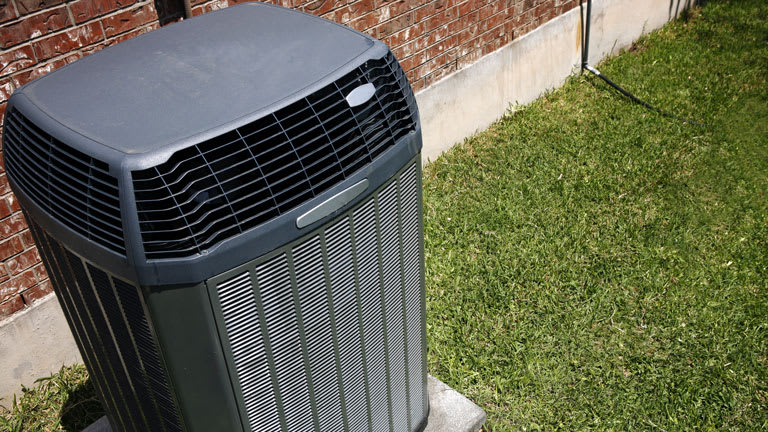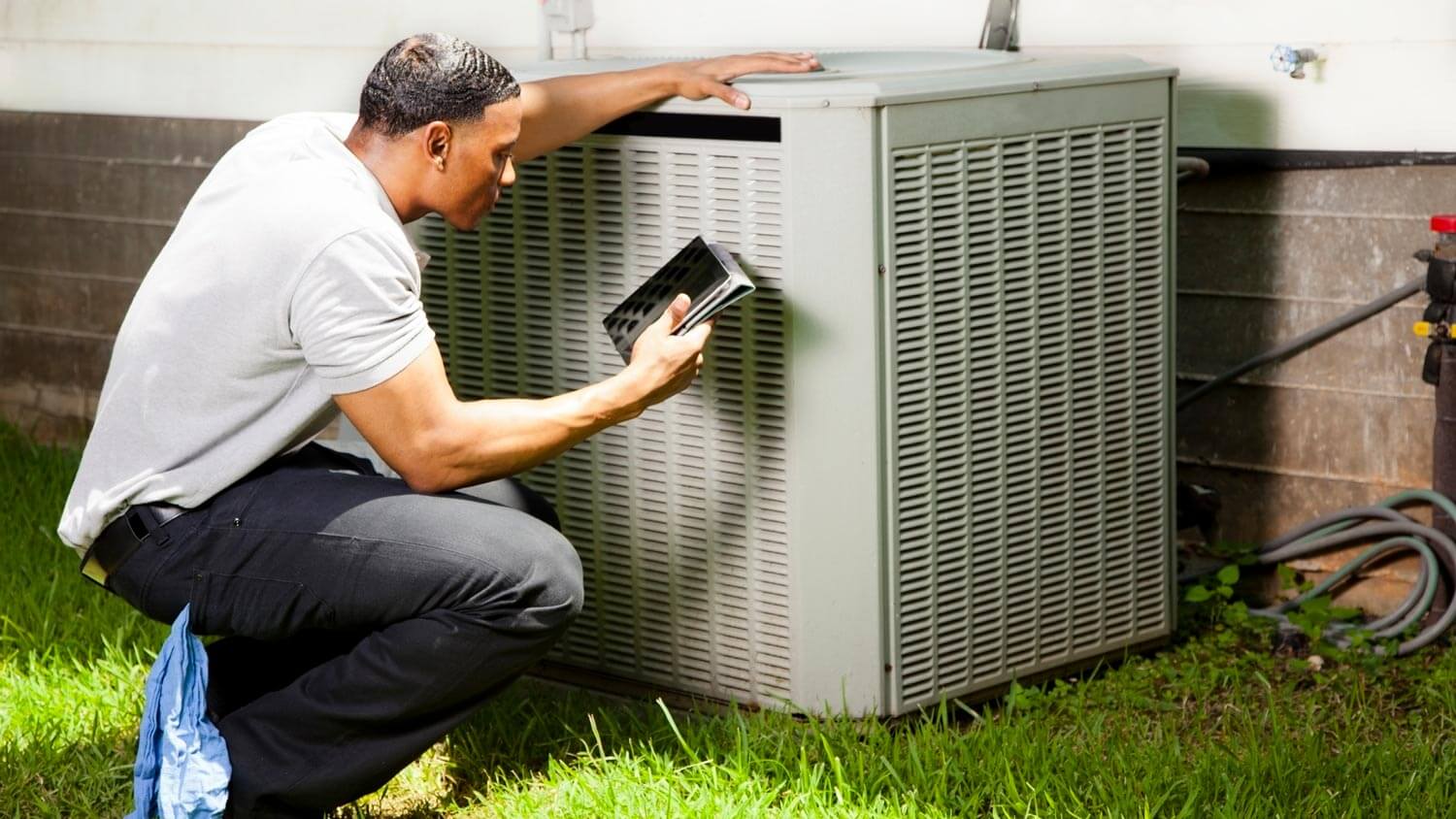
What you’ll pay in Columbus, OH, for furnace repairs depends on many factors. Here’s a breakdown of what can go wrong and the cost to fix those issues.
R-410 refrigerant costs $60 per pound on average, but can range from $40 to $75. Keep in mind you cannot purchase R-410A refrigerant without an HVAC pro.


You'll need an average of 3 pounds of R-410A refrigerant per ton to charge your HVAC system.
R-410A and other refrigerants are highly regulated and dangerous, so you'll need to hire a pro to deliver and recharge your system.
If you have refrigerant leaks, be sure to budget for repairs in addition to recharging to save money over time.
Enrolling in an HVAC service contract will reduce the risk of refrigerant leaks and can include free refrigerant refills.
R-410A refrigerant prices range from $40 to $75 per pound. To replace R-410A refrigerant in your leaky AC, you will need to hire an HVAC professional since the EPA prohibits handling AC refrigerant without a license.
R-410A is actively being phased out due to its high global warming potential. After 2025, new HVAC systems will not be manufactured using this refrigerant. Learn more about what impacts R-410A refrigerant prices below.
Keep in mind that AC refrigerant does not deplete over time and that you’ll only need to add more if your AC has a leak. If you suspect a refrigerant leak, call an HVAC repair pro near you as soon as possible to inspect and repair your unit. Never try to correct an AC leak on your own.
R-410A refrigerant costs an average of $40 to $75 per pound. This cost will continue to rise over the next several years since the supply will be reduced significantly due to the EPA phase-out. The good news is that you’ll only need to add R-410A to your AC if you have a refrigerant leak—no leak means no additional refrigerant is needed. Additionally, since R-410A will still be available to purchase in the coming years, you can avoid the cost of replacing your AC unit until absolutely necessary.
| HVAC System Size in Tons | Refrigerant Needed in Pounds | Cost Range |
|---|---|---|
| 2 | 4–8 | $160–$600 |
| 3 | 6–12 | $240–$900 |
| 4 | 8–16 | $320–$1,200 |
| 5 | 10–20 | $400–$1,500 |
Air conditioner sizes are measured in BTUs, or British Thermal Units, and tonnage. Most residential ACs range from 1 to 5 tons—the larger the unit, the more cooling power it can provide. And naturally, the larger the AC unit, the more refrigerant it uses.
Most ACs use between 2 and 4 pounds of refrigerant per ton. Here's what to expect for R-410A refrigerant prices by HVAC size.
| HVAC Size (Tons) | Refrigerant (Pounds) | Average Cost, Labor Plus Materials |
|---|---|---|
| 1 | 3 | $240–$350 |
| 2 | 6 | $360–$570 |
| 3 | 9 | $480–$800 |
| 4 | 12 | $600–$1,000 |
| 5 | 15 | $720–$1,250 |
As time goes on and the supply of R-410A begins to be shortened, your geographic location might impact the overall cost you pay. While your HVAC team will know where to order R-410A from, shipping prices will depend on availability. Toward the end of the phaseout, you could live somewhere without easy access to the refrigerant, meaning your local HVAC pro will need to have it shipped in. And if it’s coming from the opposite side of the country, you might be looking at a hefty upcharge.
Overall, labor for HVAC repairs costs between $100 and $250 per hour, so the cost of recharging your AC with R-410A will depend on the size of the related repair. And since it is illegal to handle or dispose of R-410A yourself, be sure to include this in your budget.
Federal law prohibits the handling of refrigerant without a license. Ask your pro if they are “Section 608 certified,” which means they are trained and licensed by the EPA to recharge your air conditioner with refrigerant.

The EPA only allows licensed pros to purchase ozone-depleting substances, including R-410, as it's a dangerous chemical with the power to damage your AC if mishandled or installed incorrectly. As such, this job is best left to a local appliance professional.
Refilling R-410A refrigerant could have major implications when done incorrectly, so here’s why you should hire a pro:
Only EPA-certified technicians are legally allowed to handle R-410A refrigerant due to environmental and safety regulations.
R-410A is stored under high pressure, and mishandling it can lead to injury or equipment failure.
Pros have specialized gauges, recovery systems, and refill tools to safely and accurately charge your system.
A pro can check for leaks, compressor issues, or other problems that might be causing refrigerant loss before refilling.
Overcharging or undercharging refrigerant can damage your compressor and reduce cooling efficiency.
Technicians ensure refrigerant recovery and disposal meet EPA environmental protection standards.
Most HVAC manufacturers require service to be performed by a licensed technician; otherwise, the system's warranty may be voided.
The best way to save money on R-410A refrigerant is to keep your air conditioner in excellent working order. Check out these money-saving tips:
Schedule annual inspections before the hottest part of the year to avoid bigger issues during the heaviest use period, which will come with higher service costs.
During an annual checkup, ask your HVAC technician to adjust refrigerant levels on the spot, versus scheduling another appointment.
Watch for signs of low refrigerant, such as poor or delayed cooling performance, hissing noises, or increased energy bills.
While many use the terms “R-410A” and “Freon” interchangeably, Freon is DuPont’s brand name. As the EPA began its phase-out of R-22 Freon—previously the most common type of refrigerant—the use of R-410A’s began to rise. However, you can’t just add R-410A to your R-22 air conditioner.
The EPA phase-out of R-410A and the HVAC systems that use it can be tricky to navigate. Below, we’ve broken down the quick facts you need to know if you have an AC that uses this type of refrigerant. Your local HVAC technician will be able to answer additional questions you might have about R-410A and the refrigerant that will be used in newer HVAC systems going forward.
| R-410A Refrigerant | ACs that Use R-410A Refrigerant |
|---|---|
| EPA will reduce production by 85% by 2036. It will not be discontinued in total, just reduced. | Self-contained HVAC units that use R-410A will no longer be imported or manufactured after January 1st, 2025. |
| As time passes, the cost of R-410A will continue to rise as it becomes more scarce. | Equipment built before January 1st, 2025, will have until January 1st, 2026, to be installed. Some things, like window AC units, can be installed through January 1st, 2028. |
Be ready to share the make, model, and age of your HVAC or AC unit to help the technician determine compatibility and refrigerant needs.
Explain any symptoms—such as weak airflow, warm air, or unusual noises—to help the pro diagnose potential leaks or mechanical problems.
Discuss any recent servicing, refills, or part replacements to give context for the current issue.
Describe the unit's accessibility, noting whether the system is located in a hard-to-reach area, such as an attic or a tight outdoor space.
Home is the most important place on earth, which is why Angi has helped more than 150 million homeowners transform their houses into homes they adore. To help homeowners with their next project, Angi provides readers with the most accurate cost data and upholds strict editorial standards. We extensively research project costs to develop the pricing data you see, so you can make the best decisions for you and your home. We rely on reputable sources, including the U.S. Bureau of Labor Statistics, academic journals, market studies, and interviews with industry experts—all to ensure our prices reflect real-world projects.
Want to help us improve our cost data? Send us a recent project quote to [email protected]. Quotes and personal information will not be shared publicly.
From average costs to expert advice, get all the answers you need to get your job done.

What you’ll pay in Columbus, OH, for furnace repairs depends on many factors. Here’s a breakdown of what can go wrong and the cost to fix those issues.

A blower door test can identify air leaks in your home and help boost energy efficiency. Use this blower door test cost guide to see what your test will total.

If your furnace is malfunctioning, it could be a faulty control board. Find out what a furnace control board replacement costs for parts, labor, and more.

Prepping your furnace can extend the life of your unit and stop costly repairs. Follow these furnace maintenance tips for a warm, stress-free winter.

Ductwork losing energy? Here are six duct sealing methods that will help you get some big savings on your monthly energy bills.

Thinking about installing a heat pump in your home? Learn about the different types of heat pumps and the options you can choose from in this guide.